Historie parků a zahrad v Paříži - History of parks and gardens of Paris
tento článek potřebuje úplnější citace pro ověření. (Dubna 2018) (Zjistěte, jak a kdy odstranit tuto zprávu šablony) |



V Paříži je dnes více než 421 obecních parků a zahrad, které pokrývají více než tři tisíce hektarů a obsahují více než 250 000 stromů.[1][je nutné ověření ] Dvě z nejstarších a nejznámějších zahrad v Paříži jsou Tuilerijská zahrada, vytvořený v roce 1564 pro Tuilerijský palác a přepracováno André Le Nôtre v roce 1664;[2][úplná citace nutná ] a Lucemburská zahrada, patřící k zámku postavenému pro Marie Medicejská v roce 1612, v němž dnes sídlí francouzský senát.[3][úplná citace nutná ] The Jardin des Plantes byla první botanická zahrada v Paříži, kterou vytvořil v roce 1626 Ludvík XIII doktor Guy de La Brosse pro pěstování léčivých rostlin.[4] V letech 1853 až 1870 císař Napoleon III a první ředitel městských parků a zahrad, Jean-Charles Adolphe Alphand, vytvořil Bois de Boulogne, Bois de Vincennes, Parc Montsouris a Parc des Buttes Chaumont, který se nachází ve čtyřech bodech kompasu po celém městě, stejně jako mnoho menších parků, náměstí a zahrad v sousedstvích města.[1] Od roku 1977 bylo vytvořeno sto šedesát šest nových parků, zejména pak Parc de la Villette (1987–1991) a Parc André Citroën (1992).[1]
Některé z nejpozoruhodnějších nedávných zahrad v Paříži nejsou městské parky, ale parky patřící muzeím, včetně zahrad v Paříži Rodinovo muzeum a Musée du quai Branly.
Od římských dob přes středověk

Zahrady existovaly v Paříži v římských dobách a středověku, ať už k produkci ovoce, zeleniny a léčivých bylin; pro meditaci mnichů; nebo pro potěšení šlechty; ale po původních zahradách římského města Zbyněk nezůstaly žádné stopy Lutetia.
Královský palác na Île de la Cité měl zděnou zahradu umístěnou v jižním bodě paláce, poblíž místa, kde je dnes socha Jindřicha IV. na mostě Pont Neuf. Zahrada zmizela, když Umístěte Dauphine byla postavena na počátku 17. století.[5]
Kláštery na levém břehu měly rozsáhlé zahrady a sady od středověku až do francouzské revoluce. The Jardin des Plantes byl postaven na pozemku, který původně patřil k Opatství svatého Viktora. a velká část Lucemburské zahrady dnes patřila sousednímu klášteru v Chartreux. Malá moderní rekreace středověké zahrady se nachází hned vedle Cluny Museum, bývalé sídlo opata z Opatství Cluny.
Renesanční zahrady a zahrady a la Française (1564-1700)
V roce 1495 král Karel VIII a jeho šlechtici po neúspěchu dovezli renesanční zahradní styl z Itálie Italská válka v letech 1494–1498.[6] Nové Francouzská renesanční zahrada byl charakterizován symetrickými a geometrickými výsadbovými záhony nebo parteri; rostliny v květináčích; cesty štěrku a písku; terasy; schodiště a rampy; pohybující se voda ve formě kanálů, kaskády a monumentální fontány a rozsáhlé využívání umělých jeskyně, labyrinty a sochy mytologických postav. Představovali také dlouhou osu kolmou na palác, s vodními plochami a výhledem na celou zahradu. Byly navrženy tak, aby ilustrovaly renesanční ideály míry a proporce a připomínaly ctnostům Starověký Řím.[7] Francouzští králové dováželi nejen nápady, ale také italské zahradníky, zahradní architekty a tvůrce fontán, aby vytvořili své zahrady. První příklady ve Francii byly daleko od Paříže, kde bylo více prostoru pro velké zahrady; zahrady královské Château d'Amboise (1496) Château de Blois (asi 1500), Château de Fontainebleau (1528) a Château de Chenonceau (1521), s dodatky od Kateřina Medicejská v roce 1560.
V polovině 17. století, pod Louis XIV, Francouzská formální zahrada nebo Jardin à la française, postupně nahradila renesanční zahradu; bylo formálnější a geometrickější a symbolizovalo vládu krále nad přírodou. Nejslavnějším příkladem byl zahrady ve Versailles od výrobce André Le Nôtre začátek v roce 1661. Le Nôtre předělal Tuilerijské zahrady v novém stylu počínaje rokem 1664.
Jardins des Tuileries (1564)

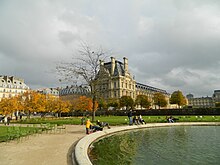

První královská zahrada renesance v Paříži byl Jardin des Tuileries, vytvořeno pro Kateřina Medicejská v roce 1564 na západ od jejího nového Tuilerijský palác. Bylo inspirováno zahradami jejího rodáka Florencie, zejména Zahrady Boboli a vyroben florentským zahradníkem Bernardem de Carnesecchi. Zahrada byla rozložena podél Seiny a rozdělena na čtverce ovocných stromů a zeleninových zahrad rozdělených kolmými uličkami a zimostrázovými živými ploty a řadami cypřišových stromů. Stejně jako Boboli, to představovalo jeskyně, s fajáns "příšery" navržené uživatelem Bernard Palissy, kterého Catherine pověřila objevením tajemství čínského porcelánu.[8]
Pod Jindřich IV byla stará zahrada přestavěna podle návrhu Claude Mollet, za účasti Pierra Le Nôtre, otce slavného zahradního architekta. Na severní straně byla postavena dlouhá terasa s výhledem do zahrady a byla postavena kruhová mísa spolu s osmibokou mísou na střední ose.
V roce 1664 byla zahrada znovu přepracována André Le Nôtre ve stylu klasiky Francouzská formální zahrada, s partery ohraničenými nízkými keři a vodními plochami uspořádanými podél široké střední osy. Přidal Grand Carré kolem kruhového umyvadla na východním konci zahrady a rampy ve tvaru podkovy na západním konci, která vede k pohledu na celou zahradu.
V roce 1667 Charles Perrault, autor Spící kráska a další slavné pohádky, navrhované Louis XIV aby byla zahrada občas přístupná veřejnosti. Jeho návrh byl přijat a veřejnost (s výjimkou vojáků v uniformách, zaměstnanců a žebráků) měla v určitých dnech povoleno promenádu v parku.[9]
Cours-la-Reine (Cours-Albert-I) (1616)

The Cours-la-Reine (jehož část se dnes jmenuje Cours-Albert-I po belgickém králi během první světové války) vytvořil Marie Medicejská, která byla stejně jako Catherine de'Medici nostalgická po svém rodákovi Florencie Byla to dlouhá promenáda (1,5 kilometru) podél Seiny původně osázená čtyřmi dlouhými řadami jilmů. Postaven před Champs Elysees, byla to populární promenáda pro šlechtu, pěšky nebo na koni.
Place Royale (nyní Place des Vosges) (1605–1612)
Place Royale (přejmenováno Place des Vosges v roce 1800) je rezidenční náměstí a veřejný park nařízený Jindřich IV a postaven v letech 1605 až 1612. Král ve svém nařízení požadoval „místo pro promenádu pro obyvatele Paříže, kteří jsou ve svých domech těsně přitlačeni“.[10] Náměstí bylo z každé strany 108 metrů dlouhé a lemováno domy stejné výšky a ve stejném stylu. Střed náměstí byl prázdný až do roku 1639, kdy byl naplněn znakem jezdecká socha z Ludvík XIII. Náměstí bylo rozděleno na záhony a trávníky diagonálními uličkami. Socha byla zničena během francouzská revoluce, poté nahrazen novou sochou v roce 1822 během restaurování. V roce 1840 byly přidány čtyři fontány.
Place Dauphine (1607) a Square du Vert-Galant (1884)

Umístěte Dauphine bylo druhé plánované obytné náměstí po Place-Royale, postavené na objednávku Jindřich IV. To bylo lokalizováno na jižním bodě Ile de la Cité, na místě zahrady starého královského paláce. To bylo jmenováno pro budoucího krále Ludvíka XIII, a byl postaven ve tvaru trojúhelníku, s bodem dotýkat Pont Neuf, která byla dokončena v roce 1606. Na most u vchodu na náměstí byla roku 1614 na návrh jeho vdovy umístěna socha Jindřicha IV. Marie Medicejská. Původní socha byla zničena během francouzské revoluce, ale v roce 1821 byla nahrazena novou sochou.
Stavba mostu spojila dva malé ostrovy s Île de la Cité; jedním z těchto ostrovů bylo místo, kde byl poslední velmistr Templářští rytíři, Jacques DeMolay byl na hranici vypálen v roce 1314. Bod ostrova pod mostem a socha Jindřicha IV. byl v roce 1884 přeměněn na veřejný park, věnovaný Vert-Galant„galantní zelená“, přezdívka Jindřicha IV., proslulého četnými romantickými styky.
Jardin des Plantes (1626)

The Jardin des Plantes, původně nazývaný Jardin royal des herbes médicinales, byla otevřena v roce 1626 pod dohledem Guy de La Brosse, lékař krále Ludvíka XIII. Jeho původním účelem bylo poskytnout léčivé rostliny pro soud. Byl postaven na pozemku zakoupeném od sousedních Opatství svatého Viktora. V severozápadní části zahrady je stále vidět labyrint a Belvedere z roku 1840. V roce 1640 se stala první pařížskou zahradou, která byla otevřena pro veřejnost.
V osmnáctém století, pod francouzským přírodovědcem Georges-Louis Leclerc, hrabě de Buffon, který ji řídil v letech 1739 až 1788, byla zahrada zdvojnásobena výměnou pozemků s opatstvím, která sahala až k břehům Seiny, a byla značně rozšířena přidáním stromů a rostlin přinesených francouzskými průzkumníky z celého světa svět. Jeden může vidět dnes a Robinia strom zasadil v roce 1636, a sophora z roku 1747.
V roce 1793, po revoluci, se královská zahrada stala Národním přírodovědným muzeem a byla přidána zoo. se zvířaty přivezenými z Versailleského paláce. Zahrada byla znovu rozšířena a byla založena škola botaniky. První skleník byl postaven v roce 1833 Charles Rohault de Fleury, průkopník v používání železa v architektuře. První z velkých skleníků, které dnes vidíme, postavil Jules André v roce 1879; skleník kaktusů Victora Blavette v roce 1910; a tropický skleník dlouhý 55 metrů od Reného Bergera v roce 1937. Alpská zahrada byla přidána v roce 1931 a růžová zahrada a Jardin des vivaces byly přidány v roce 1964.[11]
Jardin du Luxembourg (1630)


The Jardin du Luxembourg vytvořil (a) Marie Medicejská, vdova po Jindřich IV mezi lety 1612 a 1630. Bylo umístěno za Lucemburský palác, napodobenina Palác Pitti v jejím rodném domě Florencie. Začala výsadbou dvou tisíců jilmů a pověřila florentského zahradníka, Tommaso Francini, vybudovat terasy a partery a kruhové umyvadlo uprostřed. The Medici fontána byla pravděpodobně také dílem Franciniho, i když tomu se někdy připisuje Salomon de Brosse, architekt paláce.[12] Po smrti Marie Medicejské byla zahrada z velké části opomíjena. Posledním královským majitelem byl hrabě de Provence, budoucí král Ludvík XVII Já, který jsem prodal východní část zahrady za stavění pozemků.
Po francouzské revoluci se vláda Francouzský adresář znárodnil velké pépiniérenebo školky sousedního kláštera v Chartreux a připojili jej k zahradě. V roce 1862, během Druhé říše, Georges-Eugène Haussmann znovu zasadil a obnovil zahrady, ale také vzal část školky, aby vytvořil prostor pro dvě nové ulice, Rue Auguste Comte a Place André Honnorat. Medici fontána byla přesunuta zpět, aby se vytvořil prostor pro Rue de Medicis, a současná dlouhá pánev a socha byla přidána k fontáně.
Za vlády Louis-Philippe, která měla ráda hrdiny francouzské historie, zahradu zdobily sochy francouzských královen a francouzských žen. Během Francouzská třetí republika vláda přidala sochy spisovatelů, malířů, skladatelů, mýtické postavy a miniaturu Sochy svobody od Frédéric Auguste Bartholdi. čímž se počet soch zvýšil na více než sedmdesát.[13]
Jardin du Palais-Royal (1629)
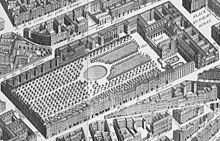

Zahrada Palais-Royal byl postaven Kardinál Richelieu, poté, co v roce 1623 koupil hôtel d'Angennes a přeměnil jej na své vlastní sídlo, Palais-Cardinal. Když zemřel, nechal to na Louis XIV, který si jako dítě hrál v zahradách a v roce 1643 se z něj stal Palais-Royal. Zahrada, kterou navrhl Claude Desgots, představoval dvě řady jilmů, propracované partery a okrasné květinové záhony, sochy, fontány a dvě umyvadla a na jednom konci háj. V roce 1692 se stal majetkem Monsieura, bratra Ludvíka XIV., A poté patřil členům orléanské větve dynastie. Po smrti Ludvíka XIV. Se stala sídlem vladaře, Philippe II, vévoda z Orléans, jehož zpustlý životní styl vyvolal mnoho skandálů. Zahrady se staly oblíbeným místem setkávání spisovatelů a také místem navštěvovaným prostitutkami.[14]
Oheň zničil velkou část Palais v roce 1773 a majitel, Louis Philippe II, vévoda z Orléans, se rozhodl proměnit jej v ziskové zařízení. Postavil arkádu obchodů a kaváren obklopujících zahradu s rezidencemi výše, s dřevěnou galerií pro promenádu kolem zahrady. Ve středisku byl zřízen cirkus pro jízdu na koni. Jelikož se jednalo o soukromé vlastnictví, neměl policie přístup. V letech před a po revoluci se zahrada a okolní budovy staly místem setkávání revolucionářů, politických debat, hazardních her a prostituce vyšší třídy. The Theater-Francaise, budoucnost Comédie-Française, zde byla založena v roce 1787. Během revoluce byla zahrada a arkáda znárodněna a hlavy gilotin byly při několika příležitostech přenášeny na štiky davem kolem zahrady, před hosty v kavárnách. Majitel zahrady, i když podporoval revoluci a změnil si jméno na Philippe-Egalité, byl v roce 1793 gilotován.
Po navrácení, nový vévoda z Orleansu, Louis-Philippe získal svůj majetek a vrátil mu úctyhodnost. Vyloučil hazardní salony a prostitutky a nechal zahradu a arkádu přestavět zhruba tak, jak vypadají dnes. Palais-Royale byl spálen komunardy v květnu 1871, spolu s Tuilerijským palácem a dalšími symboly královské rodiny, a byl přestavěn. Během 20. století byly rezidence s výhledem do zahrady domovem mnoha francouzských celebrit, včetně André Malraux, Jean Cocteau a Colette. a V roce 1986 byla přidána dvě díla moderního sochařství; uspořádání sloupců, podle Daniel Buren a fontána-socha ocelových koulí, autor Pol Bury.[15]
Anglické zahrady a pošetilosti (1700–1800)

Počínaje polovinou 18. století Francouzská zahradní krajina začal nahrazovat formálnější a geometrické jardin à la française. Nový styl vznikl v Anglii na počátku 18. století jako Anglická zahradní krajina nebo anglo-čínská zahrada. To bylo inspirováno idealizovanými romantickými krajinami a malbami Hubert Robert, Claude Lorrain a Nicolas Poussin, Evropské představy o Čínské zahrady a filozofie Jean-Jacques Rousseau.[16][úplná citace nutná ][17] Nejčasnějším příkladem stylu ve Francii byl Moulin Joli (1754–1772), podél Seiny mezi Colombes a Argenteuil. nejznámější byl Hameau de la Reine z Marie Antoinette v zahrady ve Versailles (1774–1779).
Na konci 18. století měly pařížské městské domy francouzské aristokracie na pravém i levém břehu obvykle zahrady v anglickém stylu. Největší soukromé zahrady v Paříži byly (a stále jsou) zahrady Élysée Palace (1722), nyní rezidence prezidenta Francie. a Hôtel Matignon (1725), oficiální rezidence francouzského předsedy vlády (ani jedna není přístupná veřejnosti).
The pošetilost byl specifický druh pařížského parku, který se objevil na konci osmnáctého století. Byly v soukromém vlastnictví, ale přístupné veřejnosti, byly navrženy pro zábavu i poučení a byly naplněny architektonickými modely z různých částí světa a různých století. Většina raných pařížských pošetilostí měla krátký život a byla rozdělena na stavební pozemky: nejznámější pošetilosti byly Follies of Bouexière (1760), Boutin (1766), Beaujon (1773) a Folie Saint James (1777–1780). Jediným přeživším, hodně proměněným, je Parc Monceau.[18]
Parc Monceau (1778)


Parc Monceau byla založena Phillippe d'Orléans, vévoda z Chartres, bratranec krále Ludvík XVI, bohatý a aktivní v soudní politice a společnosti. V roce 1769 začal kupovat pozemky, kde se nachází park. V roce 1778 se rozhodl vytvořit veřejný park a zaměstnal spisovatele a malíře Louis Carrogis Carmontelle navrhovat zahrady. V roce 1778, kdy se zahrada otevřela, byla Carmontelle obviněna z napodobování anglické zahrady. Ve své knize obrazů zahrady vydané v roce 1779 odpověděl: „Vůbec to není anglická zahrada, kterou jsme vytvořili v Monceau ... znovu jsme se sešli v jedné zahradě vždy a všude. Je to jednoduchá fantazie, touha mít neobyčejnou zahradu, čisté pobavení, a ne touha napodobovat národ, který při vytváření „přírodních“ zahrad vede válečkem po všech trávnících a ničí přírodu. “[19] Park obsahoval desítky fabriky, nebo stavby, včetně egyptské pyramidy, starožitné sochy, gotická zřícenina, tatarský stan, holandský větrný mlýn, minaret, římský chrám a začarovaná jeskyně. Návštěvníci zahrady byli instruováni, aby sledovali určitou cestu z místa na místo. Zážitek umocnili zaměstnanci parku v exotických kostýmech a velbloudi a další vzácná zvířata.[20]
Začátek v roce 1781, většina z fabriky byly odstraněny a Parc Monceau byl přepracován do tradičnější anglické krajinářské zahrady. Za vlády Napoleon III se park stal majetkem města Paříže a byl přeměněn na veřejný park. Části parku byly prodány za účelem výstavby velkých nových měšťanských domů, aby se pomohlo financovat stavbu parku. Park byl obklopen monumentální ozdobnou železnou bránou a plotem a osázen širokou škálou exotických stromů, keřů a květin. Během Francouzská třetí republika, park byl plný soch skladatelů a spisovatelů. Arkáda starých Hôtel de Ville, spálen Pařížská komuna v roce 1871 byl instalován v zahradě, aby poskytl malebnou zříceninu. Několik stop po původní pošetilosti, včetně egyptské pyramidy, je stále vidět.[21]
Parc de Bagatelle (1778–1787)
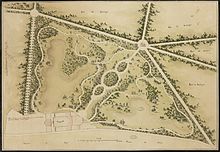


The Parc de Bagatelle vytvořil hrabě z Artois, budoucí král Charles X Francie, na části Bois de Boulogne kterou koupil v roce 1777. Udělal sázku se svou švagrovou, Marie Antoinette že mohl postavit zámek, kde by se mohla bavit za méně než tři měsíce. Stavba malého zámku začala 21. září a byla dokončena 26. listopadu. Zámek byl dílem architekta François-Joseph Bélanger, zatímco zahradu vytvořil skotský krajinář Thomas Blaikie. Zahrada byla postavena současně s Parc Monceau a stejně jako ta zahrada byla plná fabriky a pošetilosti, včetně kopce ze skal, korunovaného „pavilonem filozofů“, který byl napůl gotický a napůl čínský; obelisk, most překonaný pagodou, gotické ruiny, tatarský stan a spirálový labyrint. Všechny hlouposti postupně mizely a park se stal tradičnější anglickou zahradou. Pavilon na hromadě skal byl nahrazen tradičnější strukturou. Během druhé říše byl na počest častých návštěv zahrady císařovny Napoleona III přidán pavilon Eugénie v růžové zahradě.[22]
Po francouzské revoluci byla zahrada znárodněna a byla z ní vytvořena restaurace a místo pro plesy a slavnosti. Po obnovení monarchie byla vrácena hraběte z Artois, jehož rodina ji v roce 1835 prodala Richard Seymour-Conway, 4. markýz z Hertfordu, anglický aristokrat, který se usadil v Paříži. On a jeho dědic, Sir Richard Wallace koupil další pozemky a rozšířil zahradu ze 16 na 24 hektarů a zrekonstruoval ji přidáním nových teras, trávníků, malebného rybníka s lekníny a mnoha stromů, včetně obra sekvoje, zasazený v roce 1845, který je nyní vysoký více než 45 metrů.
V roce 1905 dědicové Richarda Wallaceho postoupili park městu Paříž, které provedlo rozsáhlé doplňky, včetně rozšířené růžové zahrady, která se stala místem Concours international de rose nouvelles de Bagatelle, mezinárodní soutěž nových růží, v roce 1907.
Garden of the Rodin Museum (1755)

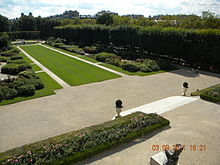
The Musée Rodin byl původně postaven v letech 1728 až 1731 jako městský dům pro Abrahama Peyrenca, bohatého pařížského výrobce paruk. Druhý majitel, vévodkyně z Maine, vytvořil dlouhou zelenou pro bowling, dvě kryté uličky a lesní háj nalevo od vchodu. Dům a zahradu koupil 1755 Louis Antoine de Gontaut, vévoda z Bironu a Marechal královské armády. Zahradu rozšířil na jih. Po návrhu architekta Pierra-Françoise Auberta a zahradníka Dominique Moisy se zahrada stala vzorem klasické francouzské formální zahrady; Trávník byl rozdělen dlouhou severojižní perspektivou a rozdělen na čtyři části květinových záhonů kolem osmnáctimetrové pánve. Východní strana zahrady byla plná stromů a na konci byla přidána oranžerie, holandská tulipánová zahrada a zeleninová zahrada. Vévoda tam často pořádal komplikované slavnosti a zahradní slavnosti a často zahradu otevřel pro veřejnost.
Vévoda zemřel v roce 1788, v předvečer revoluce. Po revoluci se dům a zahrada staly majetkem papežského legáta, poté ruského velvyslance a poté v roce 1820 náboženského řádu Dames du Sacré-Coeur-du-Jésus a sloužily jako internátní škola až do 1904. V té době bylo povodí zasypáno, zahrada z velké části nechala divoce růst, byl přidán ovocný sad. Dames také postavil novogotickou kapli v roce 1875, která se po rozpuštění řádu v roce 1904 stala rezidencí, kde si mohli spisovatelé a umělci pronajmout prostor. Sochař Auguste Rodin se stal jedním z nájemců v roce 1908. Dům a zahradu koupil francouzský stát v roce 1911. Část zahrady byla pořízena na stavbu sousední Lycée Victor Duruy, ale Rodin zůstal jako nájemce a umístil díla své sochy podél hlavní cesty . Po jeho smrti v roce 1917 se stalo muzeem věnovaným jeho práci, které bylo otevřeno v roce 1919.[23]
Mísa byla obnovena v roce 1927, ale jinak zahrada zůstala stejná, jako byla za náboženského řádu. Počínaje rokem 1993 byla zahrada přepracována zahradním designérem Jacquesem Sgardem, a to jednak jako galerie pod širým nebem, aby zobrazila Rodinova díla, ale také aby znovu zachytila vzhled formální francouzské obytné zahrady z 18. století.[24]
Parky a zahrady Napoleona III. (1852–1870)


Napoleon III se stal prvním zvoleným prezidentem Francie drtivou většinou v roce 1848. Když se nemohl ucházet o znovuzvolení, uspořádal v prosinci 1851 státní převrat a v prosinci 1852 byl sám prohlášen za francouzského císaře. Jeden z jeho prvních Prioritou císaře bylo vybudování nových parků a zahrad pro Paříž, zejména v sousedstvích daleko od centra, kde se nacházelo několik veřejných parků města.
Jmenován Napoleon III Georges-Eugène Haussmann jeho nový prefekt Seiny v roce 1853, a pověřil jej, aby postavil své nové parky. Haussmann sestavil pozoruhodný tým: Jean-Charles Adolphe Alphand, první ředitel nové služby promenád a plantáží ve městě; Jean-Pierre Barillet-Deschamps, první vrchní zahradník města; Eugène Belgrand, hydraulický inženýr, který přestavěl kanalizaci a zásobování vodou města a zajistil vodu potřebnou pro parky; a Gabriel Davioud, hlavní architekt města, který navrhoval chaty, chrámy, jeskyně, pošetilosti, ploty, brány, chaty, sloupy veřejného osvětlení a další parkovou architekturu.[25]
V průběhu sedmnácti let vytvořili Napoleon III, Haussmann a Alphand 1 835 hektarů nových parků a zahrad a zasadili více než šest set tisíc stromů, což je největší rozmach pařížské zeleně dříve i poté.[25] Postavili čtyři hlavní parky na severu, jihu, východě a západě města, znovu zasadili a zrekonstruovali historické parky a přidali desítky malých náměstí a zahrad, takže nikdo nežil od parku nebo náměstí více než deset minut. Kromě toho zasadili desítky tisíc stromů podél nových bulvárů, které Haussmann vytvořil, a natahovaly se od středu k vnějším čtvrtím. Parky v Paříži, zejména zahrady Tuileries a nový Bois de Boulogne, poskytovaly zábavu a relaxaci pro všechny třídy Pařížanů během druhé říše.
Bois de Boulogne (1852–1858)


The Bois de Boulogne byl křovinatý les na západ od města, kde po Napoleonově porážce tábořila německá, ruská a britská okupační armáda a kála většinu starších stromů.
V roce 1852 nechal Napoleon III převést pozemky ze seznamu císařského majetku na město Paříž a koupil pozemky soukromého pozemku v parku. Žil dlouhé roky v exilu v Londýně a často navštěvoval londýnské Hyde Park, s hadím jezerem a klikatými cestami. Stal se vzorem pro jeho první velký nový park. Tisíce pracovníků začaly kopat umělá jezera a přinesly balvany z lesa Fontainebleau, aby vytvořily umělou kaskádu. Belgrand, hydraulický inženýr, postavil speciální kanál z kanálu Ourq, vykopal artéské studny a položil 66 kilometrů potrubí, aby zajistil vodu pro budoucí jezera, trávníky a květinové záhony. Alphand vytyčil 95 kilometrů nových silnic, jezdeckých stezek a cest vinoucích se parkem. Zahradníci naočkovali 273 hektarů trávníku a zasadili 420 000 stromů.[26]
Park měl také sloužit k rekreaci Pařížanů; kromě cest pro kočáry a cest pro koně a procházky postavil Davioud kolem parku dvacet čtyři chat a pavilonů, které sloužily jako restaurace, kavárny, divadla a zábavní místa. Dvacet hektarů bylo vyčleněno pro zahradu a zoo Jardin d'Acclimatation. V roce 1857 se jeden roh parku stal místem Hipodrom de Longchamp, nejdůležitější dostihová dráha města. Během zimy se jezero stalo oblíbeným cílem bruslení. Od svého otevření byl park plný Pařížanů všech tříd.[27]
Bois de Vincennes (1860–1865)
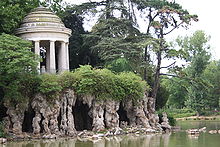

The Bois de Vincennes byla původně královská lovecká obora a místo významného královského sídla, Château de Vincennes, stále existuje. Poté, co Ludvík XIV. Přestěhoval královskou rezidenci do Versailles, byl zámek zanedbán. Pod Louis XV byl zámek přepracován a v lese byly vytvořeny turistické stezky. Během francouzské revoluce se střed parku změnil na vojenské cvičiště se střelnicemi pro dělostřelectvo a muškety. Během restaurování Louis-Philippe vzal 170 akrů lesa a postavil kasárna a vojenské kanceláře.
V roce 1860 Napoleon III postoupil velkou část lesa do města Paříže a Alphand jej začal přeměňovat na místo pro odpočinek a rekreaci pro dělnickou populaci východní Paříže. Velká část pozemku ve středu parku byla zadržena armádou, takže Haussmann byl nucen koupit další soukromé pozemky po obvodu parku, což stavělo budovu Bois de Vincennes mnohem dražší; Bois de Vincennes stojí 12 milionů franků, zatímco Bois de Boulogne stojí 3,46 milionu franků. O rozloze 995 hektarů byla o něco větší než Bois de Boulogne, což z něj činí největší park ve městě. Stejně jako to udělal v Bois de Boulogne, Alphand navrhl a vykopal dvacet pět hektarů jezer, řek, vodopádů a jeskyní. Hlavní zahradník města Barillet-Deschamps vysázel tři sta hektarů trávníků a sto čtyřicet osm hektarů květinových záhonů. Hydraulický inženýr Belgrand postavil vodní kanál z Marne River a pumpují vodu do třiceti pěti metrů k jezeru v parku, které sloužilo k zavlažování parku a plnění jezer, potoků a kaskád. Davioud vyzdobil nový park fantastickými chrámy, kavárnami, kiosky a chatami. Park byl dokončen přidáním závodní dráhy, Hipodrom de Vincennes v roce 1863 veřejná střelnice pro pistole, pušky a lukostřelbu; a císařská farma se sady, poli, ovcemi a kravami, aby mohli obyvatelé Paříže vidět v práci skutečnou farmu[28]
Bois de Vincennes byl místem cyklistických akcí v Olympijské hry 1900, na stadionu se čtyřiceti tisíci sedadly postaveném speciálně pro tuto událost. Park byl také místem dvou velkých koloniálních výstav v letech 1907 a 1931, oslavujících národy a produkty francouzské říše. Několik pozůstatků exponátů zůstává, včetně starého francouzského pavilonu Kamerun, který byl v roce 1977 přeměněn na buddhistický chrám a institut. Pařížská zoo byla postavena pro expozici roku 1931 a v roce 1934 se přestěhovala na své současné místo na východ od parku, vedle šedesát pět metrů vysoké umělé hory , obývané alpskými kozami.[29]
Parc des Buttes Chaumont (1864–1867)

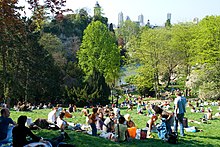
The Parc des Buttes Chaumont, dvacet sedm hektarů na severu města, bylo neperspektivním místem pro zahradu; Půda byla velmi chudá a země bez vegetace; jeho původní název byl „Chauvre-mont“ nebo „plešatý kopec“. Ve středověku to bylo blízko místa šibenice, kde byly vystaveny mrtvoly vzrušených zločinců. Od roku 1789 sloužila jako skládka odpadních vod a velká část pozemku byla využívána jako kamenolom
Alphand začal stavět v roce 1864. Byly vyžadovány dva roky a tisíc dělníků, aby místo jednoduše vyzdobili terasami a přinesli dvě stě tisíc metrů čtverečních ornice. Pro přepravu Země byla postavena malá železniční trať. Střelný prach byl použit k výbuchu skály a k vytesání 50 metrů vysokého centrálního ostrohu. Na úpatí ostrohu bylo vykopáno dvouhektarové jezero. Alphand vytyčil pět kilometrů cest a silnic a Belgrand instaloval čerpadla a potrubí pro zvedání vody z kanálu Ourq, aby zásoboval kaskády a jezero a zaléval nové zahrady. Davioud navrhl jeskyni pomocí tunelů starého kamenolomu; kruhový chrám, založený na Chrám Vesta, Tivoli, na korunu ostrohu, stejně jako čtyři mosty, které se táhnou přes jezero. Park byl otevřen 1. dubna 1867, v den zahájení pařížské světové výstavy.[30]
Městská legenda říká, že těla komunardů zabíjejí během potlačení roku 1871 Pařížská komuna jsou pohřbeni uvnitř starých kamenolomů v Promentory. Ve skutečnosti tam bylo krátce po skončení bojů umístěno 754 těl, ale krátce nato byly pohřbeny na městských hřbitovech.[31][úplná citace nutná ]
Park Montsouris (1865–1878)


Parc Montsouris byl posledním ze čtyř velkých parků vytvořených Napoleon III na čtyřech světových stranách kompasu kolem Paříže. Bylo to přesně na jih od přesného centra Paříže - památník v parku umístěný Napoleonem I. naznačoval nultý poledník který francouzské mapy používaly až do roku 1911 místo Greenwiche jako nulový stupeň zeměpisné délky. Napoleon III rozhodl o výstavbě parku v roce 1865, ale koupě pozemku si vyžádala čas a práce začaly až v roce 1867. Práce se také zpozdily, protože několik stovek mrtvol, které byly umístěny do katakomby v Paříži, jehož část ležela pod parkem, muselo být přesunuto. Park byl slavnostně otevřen v roce 1869, ale ve skutečnosti byl dokončen až v roce 1878 pod vedením Alphanda, který pokračoval ve své práci ředitele veřejných prací v Paříži Francouzská třetí republika.
Parc Montsouris o rozloze 15,5 ha měl na menším prostoru všechny prvky klasické zahrady Second Empire; jezero, kaskáda, klikaté cesty, kavárna, a guignol divadlo, trávníky a květinové záhony. It also had a remarkable folly: the Palais de Bardo, a reduced-scale replica of the summer residence of the beys of Tunis, which had originally been part of the Pařížská světová výstava z roku 1867. Made of wood and stucco, it was installed in the center of the park, where it served as a weather station, but gradually suffered from vandalism and neglect. It burned down in 1991, and was not replaced.[32]
Gardens of the Belle Epoque and the Universal Expositions (1871–1914)

Napoleon III was captured by the Germans during the Franco-pruská válka of 1870 and the Second Empire was replaced by the Francouzská třetí republika. The new government named Jean-Charles Adolphe Alphand the Director of Public Works of Paris, and he continued the work he had begun under the Emperor and Haussmann. He finished Parc Montsouris and several smaller squares, including square Boucicault (now Square Maurice-Gardette) and square d'Anvers (1877). Much of Alphand's abundant energy was devoted to the building of the universal expositions of 1878 and 1889, each of which included extensive gardens. He was in charge of building the Paris Exposition of 1889, including the construction of the Eiffelova věž. It was his last great project before his death in 1891.[33]
The construction of new squares and gardens was carried during the Third Republic by one of Alphand's protégés, the architect Jean Camille Formigé. While he did not undertake any new large parks on the scale of those of Alphand, he built a series of new squares in the Paris neighborhoods; square Ferdinand Brunot; square Frédéric Lemaître; square Adolphe Chérioux; square du Vert-Galant; square des Epinettes, and the square des Arènes de Lutèce. His most impressive accomplishment was the Serres d'Auteuil (1898), an ensemble of greenhouses which provided flowers, trees and shrubs for all of the parks of Paris.[33]
Jardins du Trocadéro (1878–1937)


The Trocadero had originally been the site of a country house of Kateřina Medicejská, then of a monastery, destroyed during the francouzská revoluce. Napoleon had projected to build a palace for his son there; King Louis XVIII planned to build a monument there to the Battle of Trocadero in 1823. Under Napoleon III, Alphand had built a basin, paths radiating outwards, a large lawn, and a stairway descending from the hill down the edge of the river.[34]
When the site was chosen in 1876 for the part of the Paris Universal Exposition of 1878, the architects Gabriel Davioud and Jules Bordais were chosen to construct the Palais de Trocadero, a massive temporary structure in a vaguely Moorish style, with large rotunda flanked by two towers, with curving wings on either side. The gardens, designed by Alphand, occupied the slope from the Palace on the top of the hill down to the Seine. The center of the garden was occupied by a long series of cascades ending in a large basin at the bottom at the bottom of the hill. The cascade was lined with statues of animals and of female figures representing the five continents (the statues now decorate the square next to the Musée D'Orsay). The largest piece of statuary in the garden was the head of the Socha svobody, made before the rest of the statue, and displayed in order to raise funds for its completion.
When the Exposition was finished, the gardens were redesigned into an Anglická zahradní krajina; groves of trees were planted, winding paths laid out, and a stream and grotto were constructed. The gardens remained in place for the Paris Universal Exposition of 1889. Pro Paris International Exposition of 1937 the palace was replaced by a modernist structure and the fountains were rebuilt, but the picturesque gardens on the hillsidewere left as they were. (See parks and gardens of the 1930s below).[34]
Champ-de-Mars (1908–1927)
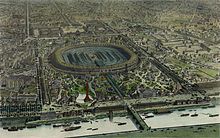

The Champ de Mars, 24.5 hectares in area, was created in 1765 as a parade ground and training field for the neighboring École Militaire. Během francouzská revoluce it was the site of large patriotic festivals, including the Festival of the Supreme Being provádí Robespierre in 1794. It was surrounded by a moat and not open to the public until 1860, when Napoleon III filled in the moat and planted trees along the borders, but it still remained the property of the Army. Bylo to místo 1867 Paris Universal Exposition, which featured a large domed pavilion in the center, surrounded a garden, which itself surrounded by a large oval-shaped gallery. The rest of the Champ de Mars was occupied by exposition halls and extensive landscape gardens, designed by Alphand.
The Champ-de-Mars served again as the main site of the Paris Universal Exposition of 1878. A gigantic palace of glass and iron 725 meters long occupied he center of the park, surrounded by gardens designed by Alphand. Pro Paris Universal Exposition of 1889, celebrating the centenary of the French Revolution, Alphand placed the Eiffelova věž in the center, near the monumental Gallery of Machines. The Exposition included a Palace of Fine Arts and a Palace of Liberal Arts. The space around the Eiffel tower and between the galleries and palaces was filled by a large landscape garden, which extended along the axis between the Eiffel Tower and the Seine, and ended at the river at a colossal fountain with a group of allegorical figures, called The City of Paris Illuminates the World with her Torch. The fountain was lit at night by electric lights shining up from the water through plates of colored glass.
In 1889, the Champ-de-Mars was formally transferred from the French army to the City of Paris. It was used once more for the Pařížská světová výstava z roku 1900, and, then, beginning in 1909 until 1927, it was developed into a public park. It was an unusual site; it was the only large park in Paris not enclosed with a fence, and it was crossed by three major boulevards. The huge Gallery of Machines, which occupied much of the site, was demolished in 1909. The park architect was Jean Camille Formigé (1849–1926), a protégé of Alphand. He used the long central axis from the Eiffel Tower to École Militaire to create a formal and symmetrical park in the French style. The long central axis was lined with paths and rows of trees; a basin with fountains was placed in the center; playgrounds were built along the sides. The original gardens from the 1889 exhibition, around the Eiffel Tower, were preserved in their original form and can still be seen. Like other French formal gardens, it was best seen from above, in this case from the top of the Eiffel Tower.[35]
Parks and gardens of the early 20th century
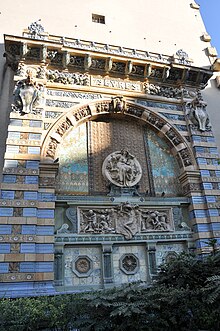
Several small parks were created between 1901 and the beginning of World War II. Náměstí Laurent-Prache was created in 1901 on the north side of the Church of Saint-Germain-des-Pres, on the site of the old Abbey of Saint-Germain, which was destroyed during the French Revolution in 1790. The wall of the church next to the park is decorated with gothic arcades taken from the destroyed Chapel of the Virgin. The centerpiece of the park today is a bronze head made by Pablo Picasso in 1959, in homage to the poet Apollinaire.

Square Félix-Desruelles was built in the same year along the south wall of the church. The little square is dominated by a colorful enameled gateway of the Pavilion of the Sèvres porcelain factory from the Paris Universal Exposition of 1900.[36]
Square René-Viviani, created in 1928, is located next to the church of Saint-Julien-le-Pauvre, across the Seine from the Cathedral of Notre-Dame-de-Paris. Its most famous feature is the oldest living tree in Paris, a robinier, Různé akácie, which was planted there in 1601 by the botanist Jean Robin. The park also contains a medieval well and fragments of gothic architecture from Notre-Dame Cathedral, taken out during its 19th-century restoration.[37]
Gardens of Sacré-Cœur (1924–1929)

The building of Basilica of Sacré-Cœur at the top of Montmartre was first proposed after the 1870 defeat of France in the Franco-pruská válka, It was also the place where the Pařížská komuna began in March 1871 with the killing of two French generals by mutinous soldiers of the Paris National Guard. Alphand's plan called for a park that would descend eighty meters from the parvis in front of the church to the street at the bottom of the hill. Architekt Jean-Camille Formigé designed a park with a dramatic and unobstructed approach to the church from the bottom of the hill; he designed two terraces, connected by stairways and by curving horseshoe-shaped ramps, lined by trees. Formigés plan also called for a cascade and fountains parallel to the stairways, but these were never built. The work on the church began in the 1880s, but proceeded very slowly, because of the difficulty of anchoring the church to the hillside, site of a former quarry. The Basilica was not dedicated until 1919. Formigé died in 1926, and the work on the gardens was finished by Léopold Béviére, and dedicated in 1929. The original name of the park was Square Willette, but in 2004, under the socialist government of Mayor Bernard Delenoye, it was renamed Square Louise Michel, after the anarchist and revolutionary who had played an active role in the Paris Commune.[38]
Parks and gardens of the 1930s

The 1930s saw an important change in the style of Paris gardens. From 1852 until the end of the 1920s, almost all Paris gardens had been designed by Jean-Charles Adolphe Alphand (1817–1891) and his protégé, Jean Camille Formigé, and they all had a similar picturesque style. Beginning in the 1930s, each Paris garden had a different designer, and the styles were varied. They tended to be more regular and more geometric, more like the classical Francouzská formální zahrada, and made greater use of sculpture, particularly the work of the modernist sculptors of the period. The gardens also tended to be smaller, and were placed in the outer neighborhoods, near the edge of the city.[39]
Several of the new parks were built on land which had been the old fortified zone around the city, a wide strip where no building was allowed, created between 1840 and 1845 by Adolphe Thiers. The land was finally turned over to the city in 1919, and supporters of green space urged that it be turned into a belt of parkland around the city, but instead the government of the Third Republic chose to use much of the land for public housing and industrial sites. Instead of a circular belt of green space, they built a series of small squares, including square du Serment du Koufra (1930) in the 14th arrondissement; square du Docteur-Calmette (1932) in the 15th arrondissement; and square Marcel-Sembat (1931) in the 18th arrondissement.
The most important landscape architects of the period were Léon Azéma, a classically trained artist who won the prestigious Prix de Rome, who designed a dozen squares, including the Parc de la Butte-du-Chapeau-Rouge; and Roger Lardat, who designed series of squares and also redesigned parts of the Bois de Vincennes and the gardens of the Trocadero.
Other notable Paris parks, gardens and squares of the 1930s are those of the Cité Internationale Universitaire de Paris (1921–1939); Parc Kellerman (1939–1950); Square Saint-Lambert (1933); Square Séverine (1933–1934); Square Sarah Berhardt and Square Réjane (1936); Parc Choisy (1937); Square René-Le-Gall (1938); and Square Barye (1938).
New Jardins du Trocadéro (1937)

The major Paris architectural and landscape project of the 1930s was the Exposition Internationale des Arts et Techniques dans la Vie Moderne in 1937, on the hill of Chaillot. The old Palace of Trocadero, which had been used in two previous exhibits, was demolished and replaced by a large terrace with a panoramic view of the Seine and Eiffel Tower, and by the modernist white Palais de Chaillot, with two wings which enveloped the top of the hill. The picturesque landscape gardens on the slopes of the hills, built by Jean-Charles Alphand for the 1878 exposition were preserved, The 21 hectares of new gardens were designed by Léon Azéma and the architects Carlu and Boileau. The central element of the garden became a series of cascades, lined with statues, and a long basin containing rows of fountains and two powerful water cannon. The basins, fountains and dramatic lighting at night were designed by Roger-Henri Expert, who also designed the interior decoration on the famous French ocean liner Normandie. Many of the statues from the exposition, by the leading French sculptors of the time, were kept in place after the Exposition, or found new homes in the other new city parks of the period.[40]
Parc de la Butte-du-Chapeau-Rouge (1939)

The Parc de la Butte-du-Chapeau-Rouge, originally known as the Square de la Butte-du-Chapeau-Rouge, in the 19th arrondissement, is one of a series of squares built in the old fortified zone which surrounded the city since the reign of Louis-Philippe. Byl navržen uživatelem Léon Azéma, and was similar to his plan for the gardens of the Trocadero two years earlier. The broad lawns and winding paths took advantage of the steep slope and served as a showcase for sculpture.
The main architectural features are the bufet d'eau, or cascading fountain, at the lower entrance, crowned by a statue of Eve by sculptor Raymond Couvènges (1938) and a classical portico with sculpture serving as the entrance to a playground. At the high end of the park, Two belvederes, reached by winding paths, offer panoramic views of the city.
Parc Kellermann (1939–1950)

Parc Kellermann was built at the same time as the Square de la Butte-du-Chapeau-Rouge, at the southern end of the city, at the edge of the 13th arrondissement. It was slightly larger than Chapeau-Rouge, (5.55 hectares compared with 4.68) which entitled it to be called a park rather than a square. It originally served as a site for several of the several smaller pavilions of the 1937 Exposition. The park was designed by the architect Jacques Gréber, who was architect-in-chief of the 1937 exposition, and who also had a notable career in the United States, where he designed the Benjamin Franklin Parkway v Philadelphie.
The site of the park had two different levels; much of the park was built in the old bed and banks of the Biévre river, now covered over. Gréber merged two different styles; the lower part of the park is picturesque, with a lake, stream, false rocks, groves of trees, winding paths and the other characteristic features of a park of the time of Napoléon III. The upper part, bordered by boulevard Kellermann, is a 1930s combination of classicism and modernism, with a cement portico, two brick excedres decorated with bas-relief sculptures in the 1930s style; a large parterre and basin; and long tree-lined alleys. The upper part of the park today offers exceptional views of the city, but also suffers from the noise of the neighboring highway that circles Paris.[41]
Parks and gardens of the late 20th century (1940–1980)
Following the German occupation of Paris in 1940, the priority shifted from making parks to making playing fields and other sports facilities, following the ideology of Marshal Philippe Pétain a Vichy Francie režim. In 1939, Paris had twenty hectares of sports fields; In 1941 the Paris government published a plan to build an additional two hundred hectares of sports facilities and playing fields, mostly using the vacant land in the old fortified zone on the edge of the city.[42]
The emphasis given to playgrounds and sports fields continued in the years after the War. The priorities of the successive French governments were the repair of the infrastructure destroyed by the War and building public housing. A number of squares were created, though most of the space was usually devoted to playgrounds rather than gardens. The new parks and squares included Squares Docteurs-Dejerine (1958), Emmanuel-Fleury (1973) and Leon Frapie (1973) in the 20th arrondissement; Squares Emile-Cohl and Georges-Melies (1959) in the 12th arrondissement; the squares around the porte de Champerret in the 17th arrondissement; and the square de la Porte-de-Plaine (1948-1952) in the 15th arrondissement.
Square Andre-Ullmann (1947), in the 17th arrondissement, is one of the typical postwar gardens; symmetrical and austere, it occupies a triangular space, with a pavilion with a rotunda in one corner, two alleys of plane trees, a central green, and bushes and shrubs carved into geometric shapes.

Square Emmanuel Fleury (1973) in the 20th arrondissement, with an area of 2.34 hectares, is larger than most of the postwar gardens, and, while it has sports fields, including a course for roller sports, it is more in the picturesque Napeoleon III style than the other postwar gardens, with rich flower beds, winding paths, groves of trees and kiosks.
Square Sainte-Odile (1976), in the 17th arrondissement, by landscape architect Jean Camand, was one of the first of a new model of gardens which appeared in the 1980s and 1990s; occupying a small space (1.13 hectare), it was divided into different spaces, each with a different style and theme, often radically different; next to a church, it includes a landscape garden in one section; a playground in another, a picturesque butte with a pavilion; a central basin with an abstract sculpture; and a monument to the harpist Lily Laskine.
Parc floral de Paris (1969)

The largest new garden created in Paris in the second part of the 20th century was the Parc floral de Paris, covering 31 hectares, which was built within the Bois de Vincennes in 1969. In 1959 and 1964 that park had been the site of a large international flower show, the Floralies internationales, and the two events had been so popular that the city decided to make a permanent site for flower exhibitions. Land was ceded to the city from military installations within the park, and the new gardens were created under the direction of landscape architect Daniel Collin. The new park was an ensemble of different flower gardens with different themes; a valley of flowers; a garden of contemporary sculptures; a water garden; and a children's garden, as well as pavilions for indoor displays and exhibits of exotic flowers, Japanese bonsaje and other botanical attractions. A Garden of the Four Seasons was added in 1979, with flowers in bloom from early spring until the end of autumn. The park also featured an outdoor theater for musical events, and small lakes and fountains.
Jardin Tino-Rossi (1975–1980)
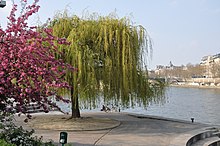
In the 19th century, the site of the Jardin Tino-Rossi, on the quai Saint-Bernard in the 5th arrondissement, had been the place where wine barrels were unloaded from barges for sale at the nearby Halle aux vins. In 1975, government of President Valéry Giscard d'Estaing decided to make the quai into a promenade, featuring rows of plantane trees planted along the quai in the 19th century, and a series of small garden amphitheaters by the edge of the water. In 1980, a more ambitious element was added; an outdoor sculpture garden featuring over fifty works by late 20th-century sculptors, including Alexander Calder, Constantin Brâncuși, a Jean Arp. While the promenade is generally considered a success, the works of sculpture have suffered over time from degradation and vandalism.[43]
Parks of the Mitterrand era (1981–1995)
During the fourteen-year presidency of François Mitterrand, coinciding with the bicentennial of the French Revolution, Paris saw an explosion of major public works projects, including the Opéra Bastille, the Louvre pyramid and underground courtyard, and the new national library. The Mitterrand projects included opening one hundred and fifty new parks, squares and gardens, a larger number than those constructed under Napoleon III, though the total area of the new parks was much smaller. Unlike the Second Empire, when all the new gardens followed the same basic plan and picturesque style, the Mitterrand-era gardens were built by different architects and landscape architects, and offered a wide variety of styles and designs, from miniature recreations of natural wilderness to high-tech. Many of the new parks and gardens, such as La Villette, were built on former industrial sites, and a majority were built in the outer neighborhoods of the city, where the population was most dense. Most all of the new parks featured works of contemporary art and sculpture.[44]
Zahradní architekt Bernard Tschumi, who designed the gardens of the Parc de la Villette, tried to explain the philosophy of the new parks in a book entitled The Parks of the 21st Century (1987) : "The conditions of the modern city have made invalid the historic prototype of a park as an image of nature. The park can no longer be conceived as a model of a utopian world in miniature, protected from vulgar reality. Rather than a place of escape, the contemporary park should be seen as an environment defined by the preoccupations of the inhabitants of the city, of their recreation needs and the pleasures defined by the working conditions and cultural aspirations of contemporary urban society."[45]
Parc Georges-Brassens (1984)
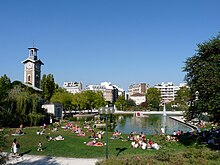
Parc Georges-Brassens (15th arrondissement), occupying 7.4 hectares, is located on the site of the former Vaugirard slaughterhouse and horse market from 1894 to 1897, which were demolished between 1969 and 1979. The design, by architects Ghiulamila and Milliex and landscape architect Daniel Collin, preserved picturesque elements of the original market, including the belfry of the old auction market of the abattoirs of Vaugirard, and the covered horse market, which now serves on weekends as the site of an antiquarian book market. Modern sculptures of horses stand at the entrance to the garden. Corners of the park are occupied by a pre-school and day care center, and a theater. The landscape garden in the center of the park, in the picturesque tradition of Alphand and the Second Empire, has a lake, winding paths, flowerbeds, a rose garden and a garden of aromatic plants. The slope of the park also has a dry cascade of artificial stones, for children to climb.
Parc de Belleville (1988)
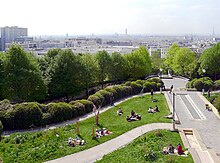
The Parc de Belleville, in the 20th arrondissement, was another early Mitterrand-era park. It was designed by architect Francois Debulois and landscape architect Paul Brichet, and built on a steeply-sloping site that covered 4.5 hectares, on the hill of Belleville, the highest point in the city. The park was located not far from the Parc des Buttes Chaumont, and shared some of the same picturesque elements as that Second-Empire park, including a terrace and belvedere at the top of the park with a panoramic view of the city, winding paths along the hillsides, abundant flowerbeds and groves of trees, and a series of cascades from the top of the hill down to a semi-circular basin, then under Rue Julian Lacroix to a circular basin in another garden in the jardin de Pali-Kao, a miniature park of three thousand square meters opened in 1989. Visitors to the park are invited to sit on the abundant lawns of the park, a practice long discouraged in Paris parks. Like Buttes-Chaumont, the Parc de Belleville originally had a grotto, built into the side of the old stone quarries, but it had to be closed because of vandalism and security concerns.
Parc de la Villette (1987–1991)

The Parc de la Villette was formerly the main slaughterhouse of the city, located in the 19th arrondissement at the intersection of the Canal de l'Ourq and the Canal Saint-Denis. One structure remains from the old site, the Grande Halle, built in 1867 by Jules de Merindol, a student of Baltard, who had built the famous glass and iron structures of Les Halles. In 1982, and international competition selected landscape architect Bernard Tschumi to design the park. The final design was composed of ten thematic gardens, which Tschumi described as a "cinematic promenade" of different sights and styles.[46]
The Parc de la Villette is more in the category of a high-tech amusement park, like Disneyland or Tivoli Gardens, than a traditional park. Twenty hectares of the fifty-five hectare site are devoted to buildings and structures, including the Cite des Sciences et de l'industrie, the Cite de la Musique, the Zenith performance hall, a full-sized submarine, and the central landmark, the mirror-surfaced Geode, a geodetická kupole. The ten thematic gardens include playgrounds and small peaceful sanctuaries; they include a garden of mirrors, a garden of shadows, a garden of islands, a garden of bamboos, a garden of dunes, and several thematic playgrounds, including one with a slide in the form of a dragon. The gardens also feature works of sculpture by noted artists and sculptors, including Claes Oldenburg a Daniel Buren.
Parc André Citroën (1992)
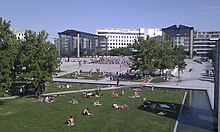
Parc André Citroën, located on the Seine in the 15th arrondissement, was the site of the Citroën automobile factory from 1915 until the 1970s. The plan for the new park was developed by landscape architects Gilles Clément and Alain Provost, along with architects Patrick Berger, Jean-François Jodry, and Jean-Pierre Viguier. Like most of the Mitterrand-era parks, it combined two very different styles of parks, a recreation park and a picturesque floral park; the centerpiece of the 24-hectare park is a large lawn, 273 by 85 meters, dedicated to recreation, sports and relaxation. The natural and pure garden aspect of the park is expressed by two very large greenhouses in the southeast overlooking the park, one an orangerie and the other displaying plants of the Mediterranean. There are also series of six small "serial gardens," each associated with a different metal, planet, state of water, and a sense; and the "Garden of movement", a meadow of different grasses blown by the wind. A canal frames one side of the large lawn, while the serial gardens, each in its own alcove, enclose the other side.[47]
Promenade plantée (1993)

The Promenade plantée, in the 12th arrondissement, is the most original of Paris parks. The creation of landscape architect Jacques Vergely and architect Philippe Mathieux, it was built ten meters above the street on the abandoned viaduct of the Vincennes railway, which had been built under Napoleon III in 1859. The park extends 4.7 kilometers, from the site of the former Bastille station of the railroad line, close to Place de la Bastille, do Verneuil-l'Étang, at the peripheric highway at the outer edge of the city. The park offers a variety of different landscapes, from bamboo forest to picturesque flower garden, as well as fine views of the city. It is accessed by a number of stairways along its route, and is sometimes enclosed. Preference is given to people strolling, though joggers are allowed, if they do not impede the promenaders. Because of the narrow width of the promenade, bicycles are not permitted.
The Promenade plantée has inspired similar parks in other cities; the Vysoká lajna in the Chelsea neighborhood of New York City, opened in 2009, and the three-mile Stezka Bloomingdale v Chicagu.
Jardin Atlantique (1994)
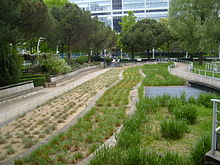
The Jardin Atlantique in the 15th arrondissement, like the Promenade plantée, has a highly unusual site, perched on twelve concrete pillars seventeen meters above street level, atop the roof over the Gare Montparnasse railway station, which connects Paris with the west of France. It was designed by landscape architects Michael Pena and François Brun, and was reportedly the most expensive park built in Paris.[48] Like the other Mitterrand-era parks, it has a central lawn, surrounded by thematic gardens and sprinkled with modern sculpture and fountains. It also has thirty openings, which provide ventilation and light for the train tracks and platforms below, and the announcements of train arrivals and departures can be heard in the park above. The design of park has a vague resemblance to the deck of an ocean liner, in keeping with the connection of the train station to the Atlantic seaports of Cherbourg and Le Havre.
Because of the weight limitations and limited depth of soil, it has a high proportion of concrete and other structural materials compared to the amount of greenery. Nonetheless, the park has five hundred trees, planted in cubic stone boxes. The thematic gardens include a garden of varied moving in the wind; a garden of aquatic plants; a garden of coastal plants, a garden of blue and mauve colored flowers; and the "hall of silence", a meditation garden.[48]
Parc de Bercy (1994–1997)


Místo Parc de Bercy, alongside the Seine in the 12th arrondissement, was at the edge of the city limits until the time of Napoleon III. It was the site of the wine depot where barrels wine and spirits were unloaded from barges and taxed before they were delivered to the city. Under the Mitterrand program, the new park was intended as the east-Paris equivalent of the Tuilerijská zahrada, alongside the Seine in the center of the city. The site already had a wide avenues lined by two hundred century-old chestnut and plantain trees, which, along with several old buildings from the wine depot, were integrated into the new park. Though the park was far from the center of the city, it was next to the new Palais Omnisports indoor sports facility and the Cinematheque (originally the American Center, designed by Frank Gehry ) and linked by a new bridge to the new National Library across the Seine. On the river side, the park was bordered by a high terrace, which blocked the noise of the highway along the river and gave view over both the Seine and the park. The park also has an amphitheater, on the site where a neolithic village was discovered.
The landscaping of the new park was designed by architects Bernard Huet, Madeleine Ferrand, Jean-Pierre Feuges and landscape architects Ian la Caisne and Philippe Raguin. Their design created three separate gardens with different themes, connected by footbridges over the streets that divide them. The western park, near at the Palais Omnisports, called Les Prairies, features broad lawns under trees; this part of the park is also used for informal sports, soccer skateboarding and rollerblading. The center park is called Les Parterres, and is devoted to serious gardening. It includes an aromatic garden, a rose garden, and a vegetable garden where school groups come to learn about agriculture and gardening. The garden on the east is called Le Jardin romantique, and it has a water theme; it includes a canal, fishponds, cascades, and a pool with water lilies.[49]
Paris parks and gardens of the 21st century
Following the late 20th century tradition of French Presidents constructing new museums and parks to mark their period in office, President Jacques Chirac zahájila Musée du quai Branly, devoted to the arts of the Americas, Africa, Asia and Oceania.
In 1991, the banks of the Seine were declared a UNESCO cultural heritage site, and efforts began to make the highways and industrial space that remained along the river into a long promenade. Beginning in 2000, sections of the highways were closed on Sundays for promenades and jogging, and an artificial "beach" with sand and deck chairs was installed in summer. In 2008, during the administration of Mayor Bertrand Delanoë (2001-2014), the city of Paris began to transform portions of the highways built along the left and right banks of the Seine into parks and recreation areas. In 2013, a 2.3 kilometer section of the left-bank highway between the Pont d'Alma and the Musée d'Orsay opened as a permanent promenade, the Promenade des Berges de la Seine.
Gardens of the Musée du quai Branly (2006)

Místo Musée du quai Branly, on the left bank of the Seine, facing the Palais de Chaillot, and just a hundred meters from the EIffel Tower, had been occupied by the buildings of the Ministry of Reconstruction and Urbanism. An international competition led to selection of architect Jean Nouvel to design the new museum. The original proposal for the museum had called for a garden occupying 7,500 square meters of the 25,000 square meter site. Nouvel increased the gardens to 17,500 square meters, and made a series of different gardens an integral part of the museum. The largest section, the "garden of movement", between the rue de l'Université and the quai Branly, is a composition of small gardens created by landscape architect Gilles Clément, designed to appear wild and to be the opposite of a French classical garden. The other notable feature of the garden is the Mur vegetale or "wall of vegetation", designed by Patrick Blanc; a composition of 15,000 plants of 150 different species which cover 800 square meters of the exterior facades of the museum and 150 square meters of the interior walls. The "wall" is renewed and trimmed each year.[50]
Promenade des Berges de la Seine (2013)

In the 19th century and early 20th century, the paved quay of the Left Bank of the Seine between the Pont de l'Alma a Musée d'Orsay had been used for several international expositions, for boat docks and storage depots, and for cafes and floating swimming pool. Between 1961 and 1967, highways were built along both banks of the river to relieve traffic congestion in the center of the city. In 1991, the banks of the river were classified as UNESCO cultural heritage site, and efforts began to turn the highways into parks and promenades. Beginning in 2008, a 2.3 kilometer section of the highway was permanently closed and made into the Promenade des Berges de la Seine, which was dedicated on June 19, 2013. The promenade includes five floating "islands", a total of 1800 square meters in size, placed atop barges, with trees, bushes, flowers and deck chairs. The former highway is lined with spaces for concerts and classes; outdoor exhibit space; playgrounds; a climbing wall; a discothèque under a bridge; and tipis and furnished containers which can be hired for lunches, celebrations or meetings. There are boat docks and several outdoor cafes along the promenade. All the facilities of the park are portable, and can be removed within 24 hours if the waters of the Seine rise too high. The promenade was designed by architect Franklin Azzi, and the islands were created by Jean-Christophe Chobet.[51][úplná citace nutná ]
Viz také
- Seznam parků a zahrad v Paříži
- French Renaissance garden
- Francouzská formální zahrada
- Francouzská zahradní krajina
- Haussmannova renovace Paříže
- Paris during the Second Empire
- Paříž v Belle Époque
Reference
Poznámky a citace
- ^ A b C Jarrassé, Dominique, Grammaire des jardins Parisiens
- ^ Lawrence & Gondrand 2010, str. 125.
- ^ Lawrence & Gondrand 2010, str. 208.
- ^ "Le Jardin de Plantes". Muséum national d’histoire naturelle. Citováno 22. června 2013.
- ^ Meunier, Florian, Le Paris du Moyen Âge, s. 37–38
- ^ Wenzler 2003, str. 12.
- ^ Wenzler 2003, str. 13.
- ^ Jarrassé, Dominique, Grammaire des jardins Parisiens, str. 46
- ^ Jarrassé, Dominique, Grammaire des jardins Parisiens, str. 47
- ^ Jarrassé, Dominique, Grammaire des jardins Parisiens str. 56
- ^ Jarrassé, Dominique, Grammaire des jardins Parisiens, str. 59–63.
- ^ Dominique Massounie; Béatrice de Andia; Daniel Rabreau (1995). Dominique Massounie; Pauline Prevost-Marcilhacy; Daniel Rabreau (eds.). Paris et ses fontaines, de la Renaissance à nos jours [Paris and its fountains, from the Renaissance to the present day]. Paris: Délegation à l'action artistique de la Ville de Paris.
- ^ Jarrassé, Dominique, Grammaire des jardins Parisiens, pp. 65–70
- ^ Dictionnaire historique de paris, str. 532–533.
- ^ Dictionnaire historique de paris, str. 534
- ^ Baltrušaitis 1978.
- ^ Wenzler 2003, str. 27.
- ^ Jarrassé, Dominique, Grammaire des jardins Parisiens, str. 74–75
- ^ cited in Jarrassé, Dominique, Grammaire des jardins Parisiens, str. 75–76.
- ^ Jarrassé, Dominique, Grammaire des jardins Parisiens, str. 75–76.
- ^ Jarrassé, Dominique, Grammaire des jardins Parisiens, str. 78–81.
- ^ Jarrassé, Dominique, Grammaire des jardins Parisiens, s. 82–83.
- ^ Jarrassé, Dominique, Grammaire des jardins Parisiens, s. 87–91
- ^ Racine, Michel, Guide des jardins en France, str. 173
- ^ A b De Moncan, Patrice, Les Jardins du Baron Haussmann, pp. 21–29.
- ^ De Moncan, Patrice, Les Jardins d'Haussmann, pp. 57–60
- ^ De Moncan, Patrice, Les Jardins d'Haussmann, pp. 60–65
- ^ De Moncan, Patrice, Les Jardins d'Haussmann, str. 75–81.
- ^ Jarrassé, Dominique, Grammaire des jardins Parisiens, str. 119–121.
- ^ De Moncan, Patrice, Les Jardins d'Haussmann, str. 101–107
- ^ du Camp, Maxime, Les Convulsions de Paris, Hachette, (1881), s. 303. (Plný text je k dispozici online z internetového archivu).
- ^ Jarrassé, Dominique, Grammaire des jardins Parisiens, s. 129–132
- ^ A b De Moncan, Patrice, Les Jardins d'Haussmann, s. 142–143.
- ^ A b Jarrassè, Dominique, Grammaire des jardins Parisiens, str. 164–165.
- ^ Jarrassé, Dominique, Grammaire des jardins Parisiens, s. 166–168
- ^ Jarrassé, Dominique, Grammaire des jardins Parisiens, s. 182–183
- ^ Jarrassé, Dominique, Grammaire des jardins Parisiens, str. 183
- ^ Jarrassé, Dominique, Grammaire des jardins Parisiens, str. 179.
- ^ Jarrassé, Dominique, Grammaire des jardins Parisiens, s. 182–187
- ^ Jarrassé, Dominique, Grammaire des jardins Parisiens, str. 201–202
- ^ Jarrassé, Dominique, Grammaire des jardins Parisiens, s. 193–195
- ^ Jarrasse, Dominique, Grammaire des jardins Parisiens, str. 210.
- ^ Jarrasse, Dominique, Grammaire des jardins Parisiens, str. 214
- ^ Jarrasse, Dominique, Grammaire des jardins Parisiens, str. 220–221.
- ^ citovaný v Jarrasse, Dominique, Grammaire des jardins Parisiens, str. 246.
- ^ Jarresse, Dominique, Grammaire des jardins Parisiens, str. 242–246.
- ^ Racine, Michel, Guide des jardins en France, s. 184–185.
- ^ A b Rancine, Michel, Guide des jardins en France / Nord str. 186
- ^ Racine, Michel, Guide des jardins en France, str. 176.
- ^ Moireau, Fabrice, Les jardins du musee du quai Branly, s. 2–9
- ^ Le Moniteur, 19. června 2013
Bibliografie
- Allain, Yves-Marie; Christiany, Janine (2006). L'art des jardins v Evropě. Paříž: Citadelles et Mazenod.
- Combeau, Yvan (2013). Histoire de Paris. Paris: Presses Universitaires de France. ISBN 978-2-13-060852-3.
- De Moncan, Patrice (2007). Les jardins du Baron Haussmann. Paříž: Les Éditions du Mécène. ISBN 978-2-907970-914.
- De Moncan, Patrice (2012). Le Paris d'Haussmann. Paris: Les Editions du Mecene. ISBN 978-2-9079-70983.
- du Camp, Maxime (1993). Paříž - Ses organes ses fonctions et sa vie jusqu'en 1870 [Paříž - její orgány, její funkce a její život do roku 1870]. Monako: Rondeau.
- Héron de Villefosse, René (1959). HIstoire de Paris. Bernard Grasset.
- Impelluso, Lucia (2007). Jardins, potagers et labyrinths. Paříž: Hazan.
- Jarrassé, Dominique (2007). Grammaire des jardins Parisiens. Parigramme. ISBN 978-2-84096-476-6.
- Maneglier, Hervé (1990). Paris Impérial - La vie quotidienne sous le Second Empire. Paříž: Armand Colin. ISBN 978-2-200-37226-2.
- Meunier, Florian (2014). Le Paris du moyen âge. Paris: Editions Ouest-France. ISBN 978-2-7373-6217-0.
- Milza, Pierre (2006). Napoléon III. Paříž: Tempus. ISBN 978-2-262-02607-3.
- Moireau, Fabrice (2009). Les jardins du musee du quai Branly. Gallimard. ISBN 978-2-74-242374-3.
- Prevot, Philippe (2006). Histoire des jardins. Éditions Sud Ouest.
- Racine, Michel (2007). Guide des jardins en France -Tome Nord. Paris: Les Editions Eugen Ulmer. ISBN 978-284138-300-9.
- Sarmant, Thierry (2012). Histoire de Paris: Politique, urbanisme, civilizace. Vydání Jean-Paul Gisserot. ISBN 978-2-755-803303.
- Wenzler, Claude (2003). Architektura du jardin. Ouest-Francie. ISBN 978-273733-177-0.CS1 maint: ref = harv (odkaz)
- Dictionnaire historique de paris. Le Livre de Poche. 2013. ISBN 978-2-253-13140-3.
